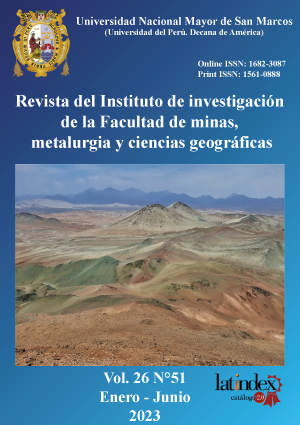Geometallurgical estimation of the work index based on synthetic domains
DOI:
https://doi.org/10.15381/iigeo.v26i51.25235Keywords:
Comminution, work index, geochemistry, decision trees and geometallurgyAbstract
The multidisciplinary geometallurgical modeling of the value chain is dependent on the areas of geology, mining and metallurgy, for this reason it is of the utmost importance in estimating the resources of the deposit. The objective of this study is to determine a methodology for modeling non-additive variables such as the work index. The methodology is based on the fact that there are geometallurgical variables whose average values do not correspond to the arithmetic mean of the domain, this is the case of metallurgical hardness variables. To achieve this objective, the database of a 100 linear km drilling campaign was used for the generation of comminution metallurgical composites, geochemical analysis and geological logging. The synthetic domain modeling was developed based on the redefinition of the alteration geochemical domains through the use of decision trees and the work index metallurgical test. A comparison of the modeling of the work index with classical geostatistics was made with respect to the proposal, finding improvements in the predictability of the R2 values of 74.56% and 93.50%, respectively. The results show that the synthetic modeling methodology based on geochemistry is based on the formation of the gangue and the host rock.
Downloads
Published
Issue
Section
License
Copyright (c) 2023 Julio Alejandro Castro Andrade, Julia Marilú Calderón Celis

This work is licensed under a Creative Commons Attribution 4.0 International License.
AUTHORS RETAIN THEIR RIGHTS:
a. Authors retain their trade mark rights and patent, and also on any process or procedure described in the article.
b. Authors retain their right to share, copy, distribute, perform and publicly communicate their article (eg, to place their article in an institutional repository or publish it in a book), with an acknowledgment of its initial publication in the Rev. Inst. investig. Fac. minas metal cienc. geogr.
c. Authors retain theirs right to make a subsequent publication of their work, to use the article or any part thereof (eg a compilation of his papers, lecture notes, thesis, or a book), always indicating the source of publication (the originator of the work, journal, volume, number and date).






